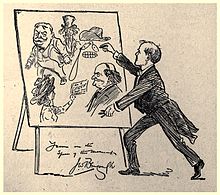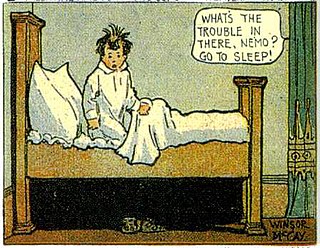
Little Nemo is a fictional character created by American cartoonist Winsor McCay. He originated in an early comic strip by McCay, Dream of the Rarebit Fiend, before receiving his own spin-off series, Little Nemo in Slumberland. The full-page weekly strip depicted Nemo having fantastic dreams that were interrupted by his awakening in the final panel. The strip is considered McCay's masterpiece for its experiments with the form of the comics page, its use of color and perspective, its timing and pacing, the size and shape of its panels, and its architectural and other details.

Gertie the Dinosaur is a 1914 animated short film by American cartoonist and animator Winsor McCay. It is the earliest animated film to feature a dinosaur. McCay first used the film before live audiences as an interactive part of his vaudeville act; the frisky, childlike Gertie did tricks at the command of her master. McCay's employer William Randolph Hearst curtailed McCay's vaudeville activities, so McCay added a live-action introductory sequence to the film for its theatrical release renamed Winsor McCay, the Famous Cartoonist, and Gertie. McCay abandoned a sequel, Gertie on Tour, after producing about a minute of footage.

Zenas Winsor McCay was an American cartoonist and animator. He is best known for the comic strip Little Nemo and the animated film Gertie the Dinosaur (1914). For contractual reasons, he worked under the pen name Silas on the comic strip Dream of the Rarebit Fiend.

Dream of the Rarebit Fiend is a newspaper comic strip by American cartoonist Winsor McCay, begun September 10, 1904. It was McCay's second successful strip, after Little Sammy Sneeze secured him a position on the cartoon staff of the New York Herald. Rarebit Fiend appeared in the Evening Telegram, a newspaper published by the Herald. For contractual reasons, McCay signed the strip with the pen name "Silas".
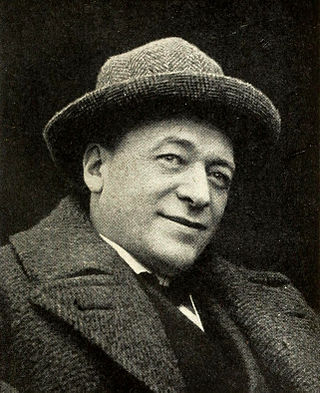
Émile Eugène Jean Louis Cohl was a French caricaturist of the largely forgotten Incoherent Movement, cartoonist, and animator, called "The Father of the Animated Cartoon" and "The Oldest Parisian".
Animated films in the United States date back to at least 1906 when Vitagraph released Humorous Phases of Funny Faces. Although early animations were rudimentary, they rapidly became more sophisticated with such classics as Gertie the Dinosaur in 1914, Felix the Cat, and Koko the Clown.
Simon in the Land of Chalk Drawings is a British children's animated series about the adventures of a young boy named Simon, who has a magic blackboard. Things that Simon draws on the chalkboard become real in the Land of Chalk Drawings, which Simon can enter by climbing over a fence near his home with a ladder. The stories often revolve around the unintended effects that Simon's drawings have on the Land of Chalk Drawings, such as when an upset Simon draws a picture of his angry self, which goes on a rampage.
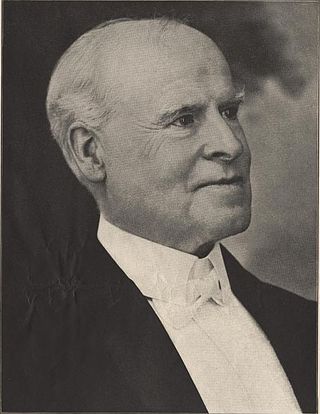
John Wilson Bengough was one of Canada's earliest cartoonists, as well as an editor, publisher, writer, poet, entertainer, and politician. Bengough is best remembered for his political cartoons in Grip, a satirical magazine he published and edited, which he modelled after the British humour magazine Punch. He published some cartoons under the pen name L. Côté.
Frank Cavalier Braxton Jr. was an African-American animator and director active in the early 1950s to the late 1960s. He was one of the first black animators hired by both Disney and Warner Bros.
"The Story of the Animated Drawing" is an episode of the Walt Disney's Disneyland television program originally broadcast on November 30, 1955.

The Sinking of the Lusitania (1918) is an American silent animated short film by cartoonist Winsor McCay. It is a work of propaganda re-creating the never-photographed 1915 sinking of the British liner RMS Lusitania. At twelve minutes it has been called the longest work of animation at the time of its release. The film is the earliest surviving animated documentary and serious, dramatic work of animation. The National Film Registry selected it for preservation in 2017.

John Randolph Bray was an American animator, cartoonist, and film producer.
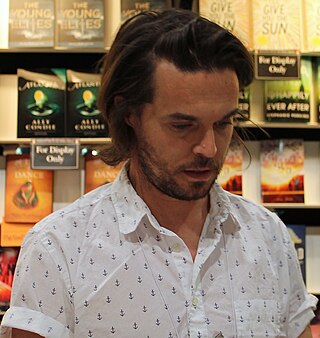
Oliver Brendan Jeffers is a Northern Irish artist, illustrator and writer who now lives and works in Brooklyn. He went to the integrated secondary school Hazelwood College, then graduated from the University of Ulster in 2001.
This is a timeline of significant events in comics in the 1900s.
George Leonard Carlson was an illustrator and artist with numerous completed works, perhaps the most famous being the dust jacket for Gone with the Wind. He is cited by Harlan Ellison as a "cartoonist of the absurd, on a par with Winsor McCay, Geo. McManus, Rube Goldberg or Bill Holman." Comic book scholar Michael Barrier called him "a kind of George Herriman for little children". In the Harlan Ellison Hornbook preface to his essay on Carlson, Ellison relates how he contacted Carlson's daughters and attempted to get the material they sent him preserved in a museum or archive, to no avail. According to Paul Tumey of Fantagraphics, Carlson's book Draw Comics! Here's How - A Complete Book on Cartooning was included in an exhibit on Art Spiegelman in the Museum of Contemporary Art Detroit in 2009.

Harry Grant Dart was an American cartoonist and illustrator known for his futuristic and often aviation-oriented cartoons and comic strips.

How a Mosquito Operates is a 1912 silent animated film by American cartoonist Winsor McCay. The six-minute short depicts a giant mosquito tormenting a sleeping man. The film is one of the earliest works of animation, and its technical quality is considered far ahead of its time. It is also known under the titles The Story of a Mosquito and Winsor McCay and his Jersey Skeeters.
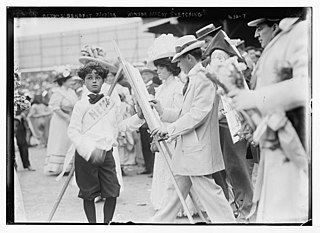
Robert Winsor McCay was an American cartoonist during the golden age of comic books. He worked professionally under the names R. Winsor McCay, Winsor McCay Jr., and Bob McCay. He was the son of cartoonist and animator Winsor McCay.
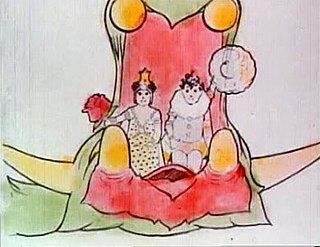
Winsor McCay: The Famous Cartoonist of the N.Y. Herald and His Moving Comics, more commonly known as Little Nemo, is a 1911 silent animated short film by American cartoonist Winsor McCay. One of the earliest animated films, it was McCay's first, and featured characters from McCay's comic strip Little Nemo in Slumberland. Its expressive character animation distinguished the film from the experiments of earlier animators.

Charles Lewis Bartholomew was an American editorial cartoonist, more commonly known as "Bart". He is most well known for his daily cartoons published by the Minneapolis Journal.


